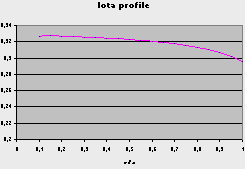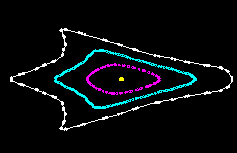Abstract : Optimization of different parameters by simulation of thousands of configurations of coils. A best configuration of coils is selected.
Content:
* New additions to SimPIMF
* Regime of the plasma in UST_1
* Loops of optimization
* Conclusions and comments
New additions to SimPIMF
Motivation for the improvement of the code
A first passable optimization was done to define the 12 modular coils in "Technical specifications of UST_1" [5]. However some inaccuracies were observed in the results. The main were:
* The position of the magnetic axis was constant for all the loops of simulation. This influenced importantly on the calculation of Iota. The position of the mag. axis was obtained manually for some of the best results.
* Moreover the calculated max. plasma size was 50mm geometrically centred and the area of good plasma was out of the area of simulation due to the different positions of the magnetic axis. Now it is 70mm. So some results in the table which seemed a bad configuration could be a satisfactory one and the optimization was only partially useful.
* Plasma size included magnetic islands and stochastic particles. Some configurations like the non optimized 13131313 has nearly all the "plasma" formed by non confining surfaces.
This deficiencies are solved in SimPIMF 2.3
The first Classes implemented (version 2.0) are described in [1]. Some additions in other pages. The present version with the new procedures will be the version 2.3. They are :
Simulation(.java) : Class to organize the simulation of an array of plasmas. Each object Simulation defines the parameters of the plasma (number of particles, type of particles....) and the method to simulate the plasma (with drifts, no drifs, electrical fields..., and the data to gather). The result is an array of results.
Iota near the magnetic axis
Methods to calculate Iota near the magnetic axis by means of the axis modelled as a series of points and a kind of toroidal-helical coordinates. Previously Iota was calculated only far from the magnetic axis by a simple method.
Bmin calculation
Methodes to calculate the value of the standard deviation of the minimums of the minimums of the magnetic field along the field line. The first minimums are produced by the finite and reduced number of modular coils and the second order of minimums by the helical configuration. The global minimums are due to 1/R effect and the rotation of the particle.
If all Bmin values on a field line are equal the confinement of deeply trapped orbits improves importantly in low collisionality regimes [2] [3] [4]. UST_1 is nearly in the collisionless regime for electrons even at low Te=10eV because of the low density (<1017m-3 ). In any case an extra parameter to be optimised is useful to improve the code and to learn about optimization.
Electrical fields calculations
The electrical fields generated from the drifts of particles are included in the simulation of velocity drifts and acceleration of particles (It was implemented in Vbasic but not in the JAVA code). It takes long time to simulate for a moderate number of quasiparticles. It will be further tested and improved.
Simulation of series of plasmas
At the moment the main procedure is able to simulate a temporal series of plasmas related among them for each loop of optimization. So results from one plasma-simulation (for ex. the magnetic axis) are used as input of the next plasmas (for ex. to calculate the rotational transform). This method is useful because different conditions of simulation and even totally different plasmas are needed to obtain different results. For example, a large number of Steps are necessary to calculate Iota while more than 50 particles with a limited number of Steps are needed to calculate the plasma size, averaged ripple and magnetic axis. One simulation is solely dedicated to obtain the points of the magnetic axis after one point of the magnetic axis on x+ has been calculated previously. The series of simulations are easily changed in order to obtain other results. The object oriented code simplifies the process. Other cases, for example the calculation of % of trapped particles require a lot of particles (~>500) and long simulations because it is a totally random simulation (Monte Carlo) . Transport calculations are also planned.
Rough pre-calculations
Optimization lasted long time because the space of parameters is wide (4 parameters) and a minimum of 74 particles are simulated during 1 microsec. up to 1milisec. for each combination. A previous rough selection of the parameters is done by means of two plasmas that calculate the magnetic axis-point and a rough Iota in one central point. If the value of Iota is out of the planned gaps (around 0.333 and 0.5) the simulation is stopped to continue with new parameters. It saves up to 90% of the simulation time.
Plasma size
A major improvement is done to better calculate the plasma size. The areas with magnetic islands and stochastic particles that tend to remain in the system (do not escape after some dozens of toroidal turns) were accounted as plasma size before. So it was oversized in different important degrees that invalidate the optimization. During the final manual detailed test it results a poor plasma and the optimization process was endless.
A new module calculates the standard deviation of the radial distances of the intersection of trajectories on the plane Y=0 x+ grouped by poloidal angle in 90 groups. If the deviation is over a threshold the trajectory does not create a closed good magnetic surface. The code has been tested graphically and it seems that works correctly.
Regime of the plasma in UST_1
Following Dolan pg 165 and comparing with the simulated bounce frequency, and Bt =0.08 , v perp/v parall = 1 , nu eff for H+~e-, bounce frec. for electrons (ions are in a collision regime):
nu eff = effective collision frequency
| Case | T (eV) | n (m-3) | Bounce frec (Hz) | nu eff(Hz) |
| RA | 2 | 1x1017 | 1.6 x 106 | 6.7 x 106 |
| RB | 5 | 1x1017 | 2.5 x 106 | 1.7 x 106 |
| RC | 10 | 1x1017 | 3.5 x 106 | 6.0 x 105 |
| RD | 2 | 1x1016 | 1.6 x 106 | 6.7 x 105 |
| RE | 5 | 1x1016 | 2.5 x 106 | 1.7 x 105 |
| RF | 10 | 1x1016 | 3.5 x 106 | 6.0 x 104 |
Only the electrons are in collisionless regime (nu eff<<Bounce freq) for low density 1x1016 and if T=10eV were reached. So the importance of simulations without collisions is only marginally for UST_1.
Could this phenomenon tend to further separate the electrons and ions and cause higher E drifts? Not known.
Moreover, Larmour radius for ions is comparable to the size of plasma. There is no solution for this issue in this small stellarator, only to increase B, what is neither possible.
The optimization is done considering that the plasma is in collisionless regime. However it was calculated [8] that Te will very low in UST_1 (maximum ~ 5eV at high 10Kw ECRH power, usually ~2eV at 1-2Kw)
Confinement time scales aprox. at square of minor radius "a" so plasma size has a major weight in the optimization.
Loops of optimization
All calculations are vacuum calculations without plasma pressure effect and the process is described in past pages.
Number of coils = 12 ; m=2
Modular coils current = 4190 A-turn
Coef for the magnetic grid = 100 for the rough pre-selection. 200 for the rest (1side of grid = 1/200m)
nº Plas : Order number of the "plasma"
nº Part : number of particles of the plasma.
t Step : increment of time per Step, nanosec.
KSteps : number of steps of simulation /1000
| nº Plas | nº Part | t Step | KSteps | Description |
| 0 | 14 | 2 | 20 | Rough mag. axis position |
| 1 | 1 | 2 | 1000 | Rough central Iota |
| 2 | 57 | 2 | 400 | Accurate size, axis,well, rip. |
| 3 | 1 | 0.1 | 15 | Magnetic axis-array |
| 4 | 1 | 0.1 | 450 | Bmin on a central point |
| 5 | 1 | 1 | 400 | Iota near edge (axis+15mm) |
| 6 | 1 | 1 | 1000 | Iota near axis (axis+3mm) |
| 7 | 57 | 0.1 | 4000 | Manually operated. Iota+ripple+mag. well profile with high accuracy |
12KSteps are approximately one toroidal turn at 0.1nSec
First series of loops:
Rough intervals of optimization were : Pitch 1 2, 3, 4 = [0.5 , 1.7] , 7 points in each interval
2401 different structures analysed.
The simulation lasted about 18 hours (old code)
Some finer intervals for Iota 0.5: Pitch 1 = 0.9 ; Pith 2 =[1.3 , 1.9] 13 points ; Pitch 3 =[1.1 , 1.9] 17 points ; Pitch 4 = [1.1 , 1.5] 3 points.
663 different structures analysed. Old code
Using version 2.3
Wide intervals for Iota~0.5 : Pitch 1 2, 3, 4 = [0.3 , 1.9] , 9 points in each interval.
6561 different structures analysed. 6 hours of simul with faster plasma nº 2 than reflected in the table.
Other finer intervals for Iota 0.5: Pitch 1 = [1.1 , 1.3] 2 points ; Pith2 =[1.1 , 1.9] 9 points ; Pitch 3 =[1.7 , 1.9] 3 points ; Pitch 4 = [0.3 , 0.8] 6 points.
324 different structures analysed. It lasted ~1 hour.
Some finer intervals for Iota 0.33: Pitch 1 = [0.8 , 1.4] 7 points ; Pith2 =[0.6 , 1.6] 11 points ; Pitch 3 =[0.8 , 1.6] 9 points ; Pitch 4 = [0.4 , 1.1] 8 points.
5544 different structures analysed. It lasted 27 hours
Other final finer intervals are simulated
A table is obtained and the results are ordered
by plasma size and/or Iota and/or Bmin.
The results are :
Size = Plasma size in mm.
I(15) : Iota at mag. axis + 15mm on X
I(3 ) : Iota at mag. axis +3mm on X
Prof = Iota profile idea = I(3) / I(15)
Bmin is the standard deviation of Bmin (avoiding the small ripple due to only 12 TF coils) on a trajectory from mag. aixs + 10mm . Multiplied by 1000 in the table.
A rip = Average ripple for the magnetic surfaces in [-12.5 , 12.5] on X
Well = Magnetic well depth at axis +15mm in %
Configur : Mnemonic number of the configuration. In the case J : 12131505 = 1.2 1.3 1.5 0.47
| Configur. | Size | I(3) | I(15) | Prof | Bmin | A rip | Well | |
| 0.5 | ||||||||
| A | 13131313 | 7.5 | 0.504 | 0.500 | 1.013 | 8.5 |
0.153 | 1.4 |
| B | 09191511 |
18.7 | 0.537 | 0.499 | 1.076 | 5.2 |
0.132 | -0.1 |
| C | 11191805 | 49.0 | 0.478 | 0.468 | 1.020 | 4.18 | 0.093 | 0.42 |
| C1 | 11151708 | 46.3 | 0.491 | 0.474 | 1.036 | 4.6 | 0.094 | 0.49 |
| D | 13091315 | - | 0.498 | 0.475 | 1.048 | 4.9 | 0.088 | 0.9 |
| E | 15191309 | - | 0.465 | 0.478 | 1.027 | 4.1 | 0.077 | 2.0 |
| 0.33 | ||||||||
| F | 15091309 | 30.0 | 0.356 | 0.340 | 1.047 | 4.8 | 0.077 | 2.5 |
| G | 11111111 | 40.0 | 0.324 | 0.306 | 1.056 | 4.9 | 0.082 | 1.7 |
| H | 13111505 | 47.5 | 0.326 | 0.319 | 1.021 | 4.3 | 0.084 | 1.4 |
| J | 12131505 | 50.0 | 0.323 | 0.318 | 1.016 | 4.3 | 0.086 | 1.2 |
Table 2
Some of the best configurations among thousands
Conclusions and comments
* 1) No correct configurations with crescent (similar to W7-X) Iota profiles were found. Only 3 configurations among thousands have crescent Iota but Shear is very low. It seems common in compact stellarators with simple coil configurations. In [4] it is stated "Vacuum rotational transform is produced in these configurations using relatively simple tilted/modulated toroidal magnetic field coils which can then be supplemented with driven plasma current. The iota profile is tokamak-like with a maximum in the centre and decreasing towards the plasma edge"
* 2) Only one "style" of configurations with Iota near 0.5 have some magnetic well depth, a big plasma size and enough shear. They are C and C1 "style". In general plasma size decreases when the other conditions improve. It reduces the space for optimization. Case 11191805 is represented in Graph 6.
With the old optimiser some plasmas seemed large but resulted relatively small and deformed, see Graph 3.
* 3) Coils are notably twisted in the case C and it will be difficult to mechanise in a first stellarator. This supports the idea of Iota~0.3333 .
* 4) It was decided to take Iota~0.5 to enhance confinement time and to emulate W7-AS that has Iota(0) below 0.5 for Beta=0 in one standard configuration [6] [7]. However the case Iota~0.333 is more easy to optimise. Only configurations with one or more Pitch parameters over 1.9 can achieve Iota~0.5 with big plasma.
* 5) The configuration 13131313 , which is the non optimized for Iota=0.5 has no plasma size. See Graph 4.
* 6) The configuration 11111111 , which is the non optimized for Iota~0.3 has regular features. Big islands at low rationals, medium plasma. See Graph 5.
Design 12131505
* 7) The design 12131505 is perhaps the best. High plasma = 50mm on X+ (near the maximum possible inside the vacuum vessel and almost the absolute maximum plasma =53mm), moderate twist of the coils, passable magnetic well and shear. To achieve bigger plasma, magnetic well and shear is reduced with respect the case H and others. See Graph 1 and Iota profile in Graph 2.
In Graph 1 the magnetic islands are searched and represented:
- In purple, the last closed magnetic surface, rational 2/7 = 0.28649 simulation value. The islands could help the divertor function like in W7-X. UST_1 has not divertor.
- In orange, near the edge = 3/10 rational.
- In red , 5/16 rational = 0.3129 by simulation.
- There are other rationals of limited importance near the edge, not represented : 4/13 = 0.3077... , 5/17 = 0.2941 , 6/19 , .......
- A confirmation of Iota near but below 0.3333. Near the centre in cyan and orange. Simulation of only ~5 toroidal turns.
Further improvements
Confinement time for the best solutions by Monte Carlo should be carried out.
References
[1] "SimPIMF v2.0 code in JAVA for simulation and optimization of coils" Vicente M. Queral . See “Past R&D" in this web
[2] "Keeping the options open ... " J Sanchez and V Tribaldos , Plasma Phys. Control. Fusion 47 (2005) B349–B361
[3] "Transport Optimization and MHD Stability of a Small Aspect Ratio Toroidal Hybrid Stellarator" S. P. Hirshman, D. A. Spong, et alt. PHYS I CAL RE V I EW LETTERS VOLUME 80, NUMBER 3
[4] "Confinement Properties of Small Aspect Ratio Tokamak/Stellarator Hybrid Devices" D. A. Spong, S. P. Hirshman, J. C. Whitson
[5] "Technical specifications of UST_1" , Vicente M. Queral . See “Past R&D" in this web[6] "Significance of MHD Effects in Stellarator Confinement Significance"
, pg 8 .Arthur Weller at al. , 15th SW2005[7] “Investigation of the Beta-Limit in the W7-AS Stellarator" Fig-13 , A. Weller , J. Geiger et al. EX/S3-1 document
[8] "Energy confinement time and estimation of the heating system in UST_1" Vicente M. Queral . See “Past R&D" in this web
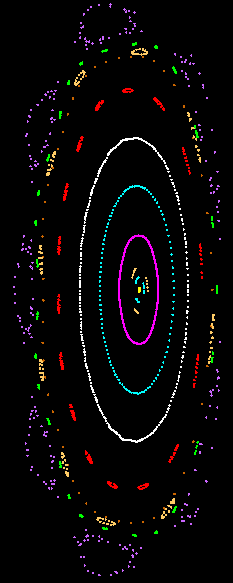
Graph 1 The best optimised configuration for Iota~0.3333. Case J in table 2. It has a big plasma size =60 x 22mm on this poloidal plane, no low rationals, acceptable magnetic well, low ripple and Bmin. (Intersection with the plane X=0 y+)
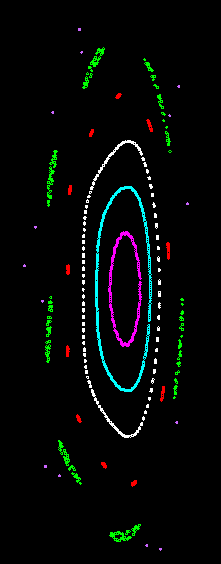
Graph 6 One of the best optimised configuration for Iota~0.5. Case C in table 2. It has a big plasma size =60 x 16mm on this poloidal plane, no low rationals, acceptable magnetic well, low ripple and Bmin. (Intersection with the plane X=0 y+)
Graph 2 Iota profile for the configuration J = 12131505
Graph 2.1 Magnetic well depth profile for the configuration J = 12131505
Colors for graphs (except Graph nº4) :
Yellow : Axis
Magenta: Axis +5mm
Cyan: Axis +10mm
White: Axis +15mm
Red: Axis +20mm
Green: Axis +25mm
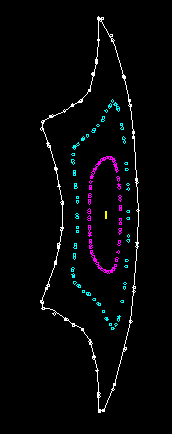
Graph 3a . Case E 15191309 . Deformed magnetic surfaces obtained by the old optimiser . It is a small plasma. (Intersection with plane X=0)
Graph 3b . Case E 15191309 . Obtained by the old optimizer. (Intersection with plane Y=0)
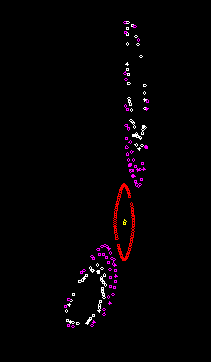
Graph 4 . Case A 13131313 . Non optimised case. The red points are only 3mm from the magnetic axis. There is practically no plasma. The rest are magnetic islands . ( Intersection with plane X=0 )
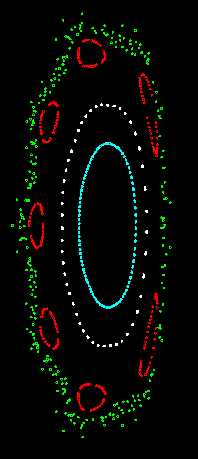
Graph 5 . Case G 11111111 . Non optimised case. Iota at axis + 20 = 0.2856 =~2/7 , rational surface, in red. (Intersection with plane X=0 y+)

Graph 6 One of the best optimised configuration for Iota~0.5. Case C in table 2. It has a big plasma size =60 x 16mm on this poloidal plane, no low rationals, acceptable magnetic well, low ripple and Bmin. (Intersection with the plane X=0 y+)

Graph 1 The best optimised configuration for Iota~0.3333. Case J in table 2. It has a big plasma size =60 x 22mm on this poloidal plane, no low rationals, acceptable magnetic well, low ripple and Bmin. (Intersection with the plane X=0 y+)
Graph 2 Iota profile for the configuration J = 12131505
Graph 2.1 Magnetic well depth profile for the configuration J = 12131505
Date of publication 19-03-2006
